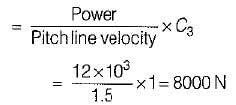Test: Gears - 1 - Mechanical Engineering MCQ
10 Questions MCQ Test - Test: Gears - 1
The gears are termed as medium velocity gears, if their peripheral velocity is
Two mating spur gears have 70 and 30 teeth respectively. Corresponding to module pitch 6 mm, the center to center distance between gears will be
Which aspect is not true for a stub tooth when compared to full depth system?
Allowable tooth stress for gear-tooth design depends upon the following parameters:
1. Type of gear material
2. Pitch line velocity
3. Beam strength of gear teeth
Which of the above is/are valid?
The tooth profiles must not have excessive contact stress as determined by the wear load to insure durability of a gear pair. This wear load is obtained using
A pair of straight teeth spur gears with 6 mm module, having 20° involute full depth teeth is to transmit 12 kW at 300 rpm of the pinion. The speed ratio is 3:1. The allowable static stresses for gear of cast irion and pinion of steel are 60 MPa and 105 MPa respectively.
Assume the following:
Number of teeth on pinion = 16;
Face width = 14 m;

σes - 600 MPa; Ep = 200 GPa; EG = 100 GPa; Service factor, Cs = 1; sin20° = 0.342.
Based on these design data, match the followings:


Cycloidal tooth profile of a cycloidal gear tooth is a combination of

























